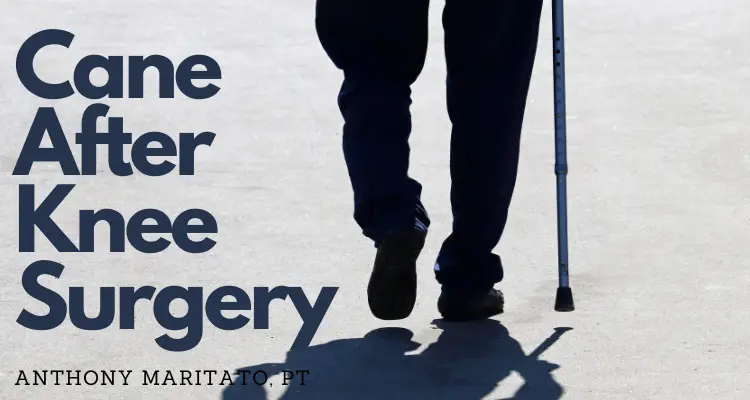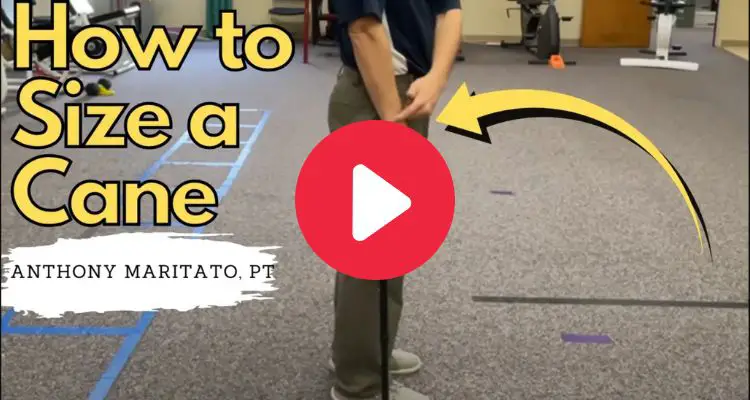How to Use a Cane After Knee Surgery

Understanding the Purpose of Using a Cane after Knee Surgery
Knee surgery, particularly knee replacement, can be a life-altering procedure that improves mobility and reduces pain for those suffering from chronic knee conditions. Recovery, however, requires careful rehabilitation and the temporary use of mobility aids. One such aid is the cane, an essential tool for many individuals following their knee surgery.
There are several key reasons for using a cane after knee surgery. Let’s discuss them in detail:
Support and Balance
One of the primary purposes of a cane is to provide additional support and balance during your recovery. After knee surgery, it’s normal for your leg strength and balance to be affected. A cane acts as an extra leg, giving you stability, reducing the risk of falls and increasing confidence while you navigate your daily activities. It’s especially useful during transitional movements such as climbing stairs or getting in and out of a car. * In these cases a cane is just a way to touch the ground. It helps to steady your body while you lift one of your legs to step up, in, or over an obsticle.
Offloading Weight
A cane can also help by offloading weight from your affected knee. This is crucial in the early stages after surgery when your knee is still healing, and bearing full weight might not be advisable. By redistributing some of the body’s weight to the upper body and the unaffected leg, a cane can ease discomfort and promote healing.
In this case the cane is most often used opposite the surgical knee. The cane is advanced when the surgical leg steps forward.
Enhancing Rehabilitation
Another benefit of using a cane is that it can aid in your rehabilitation process. With the assistance of a cane, you can gradually improve your walking pattern and gait, crucial components for a successful recovery. Furthermore, using a cane can facilitate the return to activities like exercise biking and walking your dog, while ensuring your safety and confidence.
My patients are often concerned that they will become dependent on a cane or that a cane will make them weaker in some way. The reality is, a cane provides that added assurance and usually results in my patients walking more total steps per day with more confidence and a better walking gait pattern.
Gradual Progression Towards Independent Mobility
Finally, a cane serves as a transitional tool on your journey towards independent mobility. After surgery, many individuals start with a walker for support and then move to a cane as strength and balance improve. This progression is an important part of the recovery process, allowing you to regain your independence step by step.
The use of a cane after knee surgery is not just about getting around. It’s an integral part of your recovery journey, offering support, stability, and a means to regain your mobility. Each individual’s needs and progression can vary, so it’s important to follow your physical therapist’s guidance regarding the appropriate use of mobility aids.

How to Properly Use a Cane after Knee Surgery
Using a cane correctly is key to reaping its benefits during your recovery from knee surgery. Improper usage can result in discomfort, imbalance, and potential injury. Let’s walk through a step-by-step process on how to correctly use a cane after knee surgery.
| Step | Description |
|---|---|
| 1 | Adjust the cane’s height: Stand straight and let your arm hang at your side. The cane’s handle should align with the crease of your wrist. Adjust the cane’s height until this alignment is achieved. |
| 2 | Hold the cane on the unaffected side: Contrary to what many believe, the cane should be held in the hand opposite to the affected knee. This allows the cane and the affected leg to swing and strike the ground together, providing more support and stability. |
| 3 | Move the cane forward as you step with the affected leg: As you take a step with your affected leg, move the cane the same distance forward. This ensures that the cane and the affected leg provide support together. |
| 4 | Follow through with the unaffected leg: Complete the step by then moving the unaffected leg forward, past the cane and the affected leg. You should not need to lean on the cane; it is there for balance and support. |
| 5 | Repeat the process: Continue the above process with each step. Practice under the supervision of a physical therapist initially to ensure proper technique. |
Remember, every individual’s recovery process is unique, and so is their progression from a walker to a cane, and finally to independent walking. This progression should always be guided by a professional. They will take into account your specific situation and prescribe exercises to help you regain strength and balance, eventually reducing your reliance on the cane.
If you experience discomfort, or if you feel that your balance is off despite correctly using the cane, it’s essential to communicate this with your physical therapist. They can help make necessary adjustments to your cane or your technique to ensure your safety and comfort.
Common Mistakes to Avoid When Using a Cane
As crucial as it is to know how to correctly use a cane after knee surgery, it’s equally important to be aware of the common mistakes that could impede your recovery. Avoiding these pitfalls will ensure you get the maximum benefit from your cane while maintaining your safety and comfort.
Here are some typical errors and how to avoid them:
❌ Incorrect Cane Height: A cane that’s too tall or too short can cause discomfort and impact your balance.
✅ Always adjust the cane’s height so that the handle aligns with the crease of your wrist when your arm is hanging at your side.
❌ Holding the Cane on the Wrong Side: Using the cane on the same side as your affected knee can throw off your balance.
✅ Always hold the cane in the hand opposite to your affected knee.
❌ Over-Reliance on the Cane: Using the cane for all weight-bearing can slow down your recovery.
✅ Use the cane for balance and stability, not as the primary weight-bearing tool. The ultimate goal is to progressively reduce dependence on the cane.
❌ Skipping Physical Therapy: Avoiding prescribed exercises can delay your recovery and increase the time you’ll need to use a cane.
✅ Engage in the recommended physical therapy exercises regularly to regain strength and improve balance.
❌ Ignoring Pain or Discomfort: If cane usage causes pain or discomfort, don’t ignore it. This could be a sign of improper use or other underlying issues.
✅ If you experience any pain or discomfort, consult with your physical therapist immediately. They can identify the issue and make necessary adjustments.
Remember, your safety and successful recovery are paramount. If you’re unsure about anything, it’s always best to seek advice from your physical therapist.
Transitioning from a Walker to a Cane: When and How?
Transitioning from a walker to a cane is a significant milestone in your recovery from knee surgery. This shift represents an improvement in balance and strength. However, it’s important to know when and how to make this transition to ensure it is safe and effective.
When is the right time to switch? The answer will depend on your individual progress and should always be made under the guidance of a physical therapist. Typically, you might be ready to switch to a cane when:
- You can stand and balance without support
- You have regained some strength in the affected leg
- You can walk small distances with minor assistance
- Your surgeon or physical therapist gives you the approval
If you meet these criteria, you might be ready to transition from a walker to a cane. The “how” of this process is equally important. Here are some tips:
✅ Start with a quad cane: A quad cane has four points of contact with the ground and offers more support than a single-point cane. It can be a good stepping stone in this transition.
✅ Practice with your physical therapist: Your first few attempts to walk with a cane should be under the supervision of a physical therapist. They can correct your technique and ensure you’re using the cane safely.
✅ Gradually increase your walking distance: Start with short distances, and gradually increase as your comfort and confidence grow.
✅ Listen to your body: If you experience discomfort, fatigue, or if your balance is off, it might be too soon to switch to a cane. Don’t push yourself too hard – your recovery will progress at its own pace.
Remember, everyone’s recovery journey is different. You might transition to a cane quickly, or you might need a walker for a longer period. Both are perfectly fine, and your recovery journey should not be rushed. What’s important is moving forward safely and at a pace that’s right for you.
Key Takeaways
In summary, understanding how to properly use a cane after knee surgery is essential for your recovery. Here are the key takeaways from this article:
| Takeaway | Description |
|---|---|
| 1. Purpose of the Cane | Understand that a cane is primarily used for balance and support during the recovery process after knee surgery, not for bearing all your weight. |
| 2. Correct Usage | Proper use of a cane involves holding it on the opposite side of your affected knee and moving it forward as you step with the affected leg. |
| 3. Common Mistakes | Avoid common mistakes like incorrect cane height, over-reliance on the cane, and skipping prescribed physical therapy exercises. |
| 4. Transitioning from a Walker | Transitioning from a walker to a cane is a significant milestone. This should only be done when you can balance without support, and under the guidance of a physical therapist. |
Remember, every individual’s recovery journey is unique. Always consult with your healthcare provider or physical therapist before making any changes to your recovery plan.

Anthony Maritato, PT
Physical Therapist
Anthony Maritato, PT has been a licensed physical therapist and private practice owner since 2006. Ohio license #PT011602.
Anthony has been passionate about helping patients recover from total knee replacement surgery as well as rotator cuff repair surgery.

Stool Scoots Exercise aka Chair Scoot Exercise | AMAZING Knee ROM 2022
What is the Chair Scoot Exercise? The chair scoot exercise is a great exercise for anyone who has had arthroscopic knee surgery or a total knee replacement. It is a great option for people who have had a partial knee replacement as well. It is a simple exercise to...

3 BEST Ways to get up from a Fall After Knee Replacement Surgery
How Common Do People Fall After Knee Replacement Surgery? A fall after knee replacement surgery is fairly common. One study found that "the number of falls reported following TKA ranges between 14.1 and 38.3%." Link What can cause a Fall After Knee Replacement Early...

Who Orders the Antibiotics After Knee Replacement Before Dental Work
Are Antibiotics Required Before Dental Work After Total Knee Replacement The topic of prophylactically using antibiotics after knee replacement before dental work remains controversial. Link This 2016 publication in Arthroplasty Today, suggests "Current international...

Second Knee Replacement 5 Quick FAQs
Is a second knee replacement worse than the first? There is a huge difference between the second knee replacement on the same knee, also known as a total knee revision surgery, and the second knee replacement on the other knee. As a physical therapist, I am fortunate...

3 Months After Total Knee Replacement
What to expect 3 months after total knee replacement During the first 3 months after total knee replacement, you may experience lots of changes and rapid improvement. Range of motion will go from practically nothing to 120 degrees of flexion and 0 degrees of...

How to Choose the Best Recliner for Knee Replacement
Is a recliner required after total knee replacement surgery? Absolutely not! A recliner might be a convenient luxury, but if you don't already own one I would not tell you to rush out and buy one. In this article, I will discuss how to achieve the same positions on a...
![Best Ankle Pumps Exercise [Video] 3 Tips After Total Knee Replacement Surgery](https://totaltherapysolutions.com/wp-content/uploads/2022/08/ankle-pumps-after-total-knee-replacement-surgery-2.jpg)
Best Ankle Pumps Exercise [Video] 3 Tips After Total Knee Replacement Surgery
What are ankle pumps? Ankle pumps are a simple and effective exercise for post-surgery recovery and sedentary lifestyles after knee replacement surgery. Ankle pumps, as the name suggests, are simple exercises involving the rhythmic flexing and extending of the ankle,...

Why Does A Knee Pop When Standing From A Chair: Total Knee Replacement Questions
Facebook Question About A Knee Pop Sensation "I am 2 yrs post op on my right knee and when I get up from a sitting position it makes a pop sound almost all of the time. Is that normal." My response: Watch the video below to localize where the knee popping is coming...

How to Shower After Knee Surgery 2022
When and How to Shower After Knee Surgery: Post Surgical Instructions Timeline Consult your surgeon or surgical team before showering. They will provide recommendations specifically for your post-surgical situation. Dr. Paul G. Kiritsis, M.D. suggests his patients are...